Speech Visualization
An Easy to Use Spectral Speech Tool
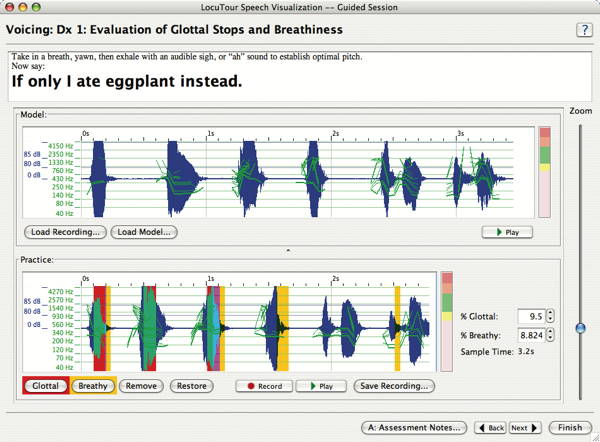
Now your clients can see their speech! This spectral speech tool allows real-time viewing of speech; visual comparison between speech models; analysis of the voice sample; and simplified record keeping. Easy to use menus let you customize your sessions. Click here for an overview.
Target Audience A Clinician's tool to use with individuals with: Voice Disorders, Cleft Palate, Dysfluencies, Deafness, Hard of Hearing, Cochlear Implants, Dialect Differences, Articulation Disorders, Parkinson Disease, Traumatic Brain Injury, Dysarthria, Apraxia, Asperger Syndrome, Prosodic Speech disorders, Down Syndrome, and Age-related Voice changes.
Download a Demo.
- Speech Visualization Demo for Macintosh 45MB (OSX 10.2.5 and above)
- Speech Visualization Demo for Windows 48MB (Windows 2000 or newer)
Speech Visualization
by LocuTour Multimedia
Information for Professionals
Speech Visualization targets seven communication areas: Breath Support and Loudness; Pitch and Intonation; Voicing; Timing, Rate, and Rhythm; Phonological Accuracy; Syllable Stress and Sequencing; and Vocal Quality and Resonance. It is an easy to use spectral speech tool that allows real-time viewing of speech; visual comparison between speech models; analysis of the voice sample using common terminology; and simplified record keeping.
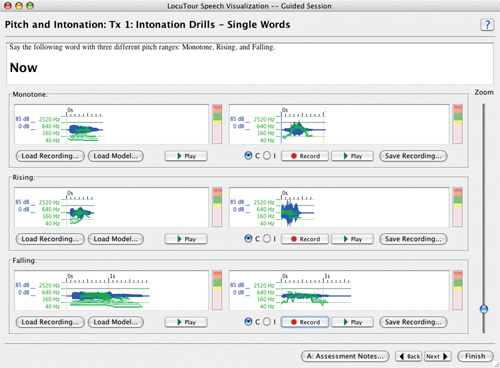
Record the clients waveform and a model waveform for comparison, view clients speech waveform in real-time, analyze voice qualities and keep detailed records with LocuTour's Client Manager. The program targets seven communication areas: Breath Support and Loudness; Pitch and Intonation; Voicing; Timing, Rate, and Rhythm; Phonological Accuracy; Syllable Stress and Sequencing; and Vocal Quality and Resonance. Client Manager is included with this CD so that you can track progress and manage client sessions.
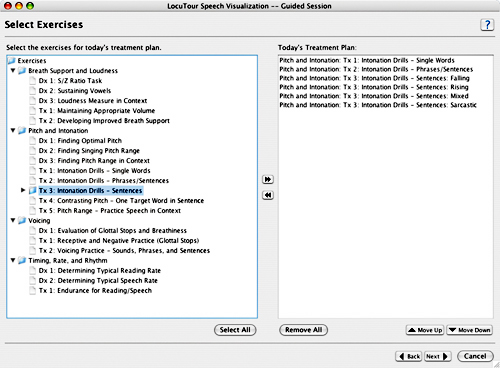
Select the exercises for the session and the program will guide you through them. At the end of the session you can generate a report

that summarizes performance on the activities and any notes that you have made during the session. You can edit the report in any word processor and print it or save it for later use.
Appropriate for individuals with: Voice Disorders, Cleft Palate, Dysfluencies, Deafness, Hard of Hearing, Cochlear Implants, Dialect Differences, Articulation Disorders, Parkinson Disease, Traumatic Brain Injury, Dysarthria, Apraxia, Asperger Syndrome, Prosodic Speech disorders, Down Syndrome, and Age-related Voice changes.
Games on this CD.
Breath Support and Loudness

This module contains three assessment exercises. The S/Z Task for calculating the client's S/Z ratio. Sustaining Vowels for measuring the client's length of production and decibel range. Loudness Measure in Context for measuring loudness when the client is speaking normally.
Pitch and Intonation
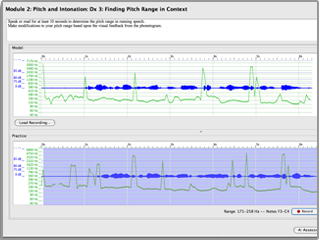
This module contains three assessment exercises and four therapy exercises. Finding Optimal Pitch measures the clients pitch range when producing the sound “ah”. Finding Singing Pitch Range finds the highest and lowest notes the client can sing. Finding Pitch Range in Context determines the pitch range in running speech.
The therapy exercises allow the client to practice changing intonation. Intonation Drills—Single Words provides practice for monotone, rising, and falling production to convey different meanings for each word. Intonation Drills—Phrases/Sentences provides the same practice and feedback but with phrases and sentences. Intonation Drills—Sentences extends the exercises to sentences with four different intonations: Falling, Rising, Mixed, and Sarcastic.
Voicing
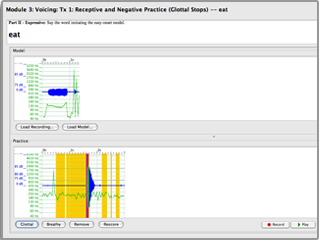
Evaluation of Glottal Stops and Breathiness is an assessment exercise for evaluating the client's speech for inappropriate glottal stops and breathiness.
The two therapy exercises provide receptive and expressive practice. Receptive and Negative Practice (Glottal Stops) and Voicing Practice—Sounds, Phrases, and Sentences show three productions of the word, incorrect with glottal attack, H + Vowel, and correct. After listening to the models the client practices speaking the word correctly.
Timing, Rate, and Rhythm
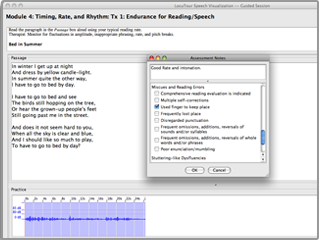
This module contains two assessment exercises Determining Typical Reading Rate and Determining Typical Speech Rate for measuring the clients reading and speech rates.
The therapy exercise Endurance for Reading/Speech can be used for either reading or speech practice.
Phonological Accuracy
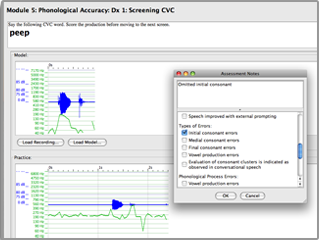
This module contains three assessment exercises. Screening CVC evaluates the client's speech for accurate production of 24 consonant and 16 vowel sounds. Deep Test IMF evaluates the client's speech for 24 consonant sounds in the initial, medial, and final positions. Screening R, S, L CLusters, Other Clusters, and R-Controlled Vowels provides screening for 72 sounds.
Syllable Stress and Sequencing

The assessment exercise in this module Syllable Sequencing (Diadochokinesis) uses rapid syllable repetition as a measure of oralfacial motor impairment.
There are four therapy exercises Alternating Syllable Practice allows the client to accurately sequence syllables. Challenging Words, and Common Challenging Words for L2 Speakers contain a selection of words with various types of syllable stress and sound sequencing. Speech In Context contains rhythmic passages that focus on articulating rapidly alternating sounds.
Vocal Quality and Resonance
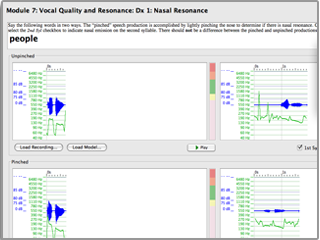
This module contains five assessment exercises and one therapy exercise. Nasal Resonance allows you to evaluate the vocal qualities and resonance of the speaker when producing words with /p/'s and /b/'s with an “unpinched” and a lightly “pinched” nose. Pressure Consonants uses words starting with /b/ and having different vowel sounds. /i, u/ “ee, oo” Contrast checks for nasal emission when producing the sequence “ee, oo ee, oo, ee, oo”. Paragraph Test has the client read a paragraph that has no nasal consonants and the therapist counts nasal productions. Counting “60-100” contains numbers with high pressure consonants (60s), heavily loaded with nasal sounds (70s), normal (80s), and normal for speakers without closure problems (90s).
The therapy exercise Using the Soft Palate in Nasal and Non-nasal Sounds provides practice in saying words with a vowel before the nasal sound.
